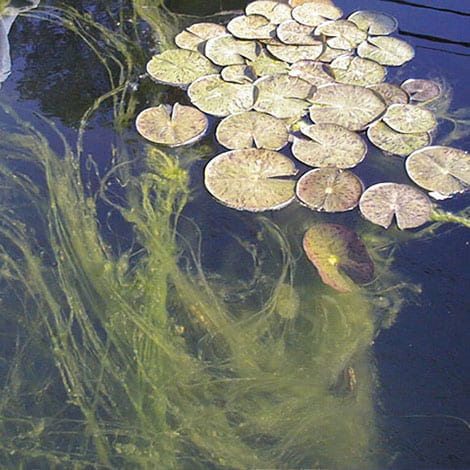A: Sometimes it's just easier to start from scratch – particularly if you have a disaster in your pond.
A complete water change rids your water feature of excess organic waste, clears up murky water (briefly, as you've discovered) and gives you a chance to start over with a clean slate. Those are some worthy benefits!
The urge to purge, however, has its drawbacks. If you've completely drained the water from your pond and scrubbed everything clean, you've also stripped a lot of the beneficial bacteria that was working to help clean the pond in the first place! The algae that's growing now is most likely due to fish waste and a lack of mature filtration.
To return your pond to its crystal-clear state, here's what we recommend.
- Decide how bad it really is: Believe it or not, some algae in your pond is natural and beneficial as it helps filter the water. Make sure your expectations are in line with the reality of having a pond, and then let the pond take its natural course with a little help from you. But be patient! The Nitrogen Cycle will eventually help clear things up naturally – but it takes time. If your water quality begins to suffer a few weeks in, think about doing a partial water change and/or following these additional suggestions.
- Treat if necessary: If the algae is becoming excessive, treat the algae growth with an algaecide in the morning or evening when water temperatures are cooler. In addition, make sure you have adequate aeration to ensure oxygen levels stay high for your finned friends.
- Seed Your Filter Media: To kick-start the regrowth and reproduction of beneficial bacteria in your pond, add some DefensePAC to your pond and filter. The package contains Nature's Defense, which instantly begins breaking down dead organics in the pond; Clarity Defense, which helps clear debris suspended in the water column; and Muck Defense, which attacks buildup on the liner, rocks and gravel.
- Condition the water: When you refill your pond with water, be sure to use Stress Reducer Plus to condition the water and reduce fish stress. It helps your fish form a beneficial slime coat that's lost from stress or handling, and it also makes tap water safe by working to remove chlorine, chloramines and heavy metals.
- Learn from the situation: Instead of letting your pond fall into its "mess" state again, figure out why it wound up in that situation in the first place. Are there too many fish living in your pond? Is your filter too small for your pond's volume and fish load? Do you need more plants growing in and filtering the water? Does your pond receive too much sun or rain runoff? Dig down to the root cause of the problem and correct it!
In the future, if you find your pond's water quality waning, consider doing a partial water change instead of a complete water change. A little fresh water will go far to clear things up without having to start completely over!

